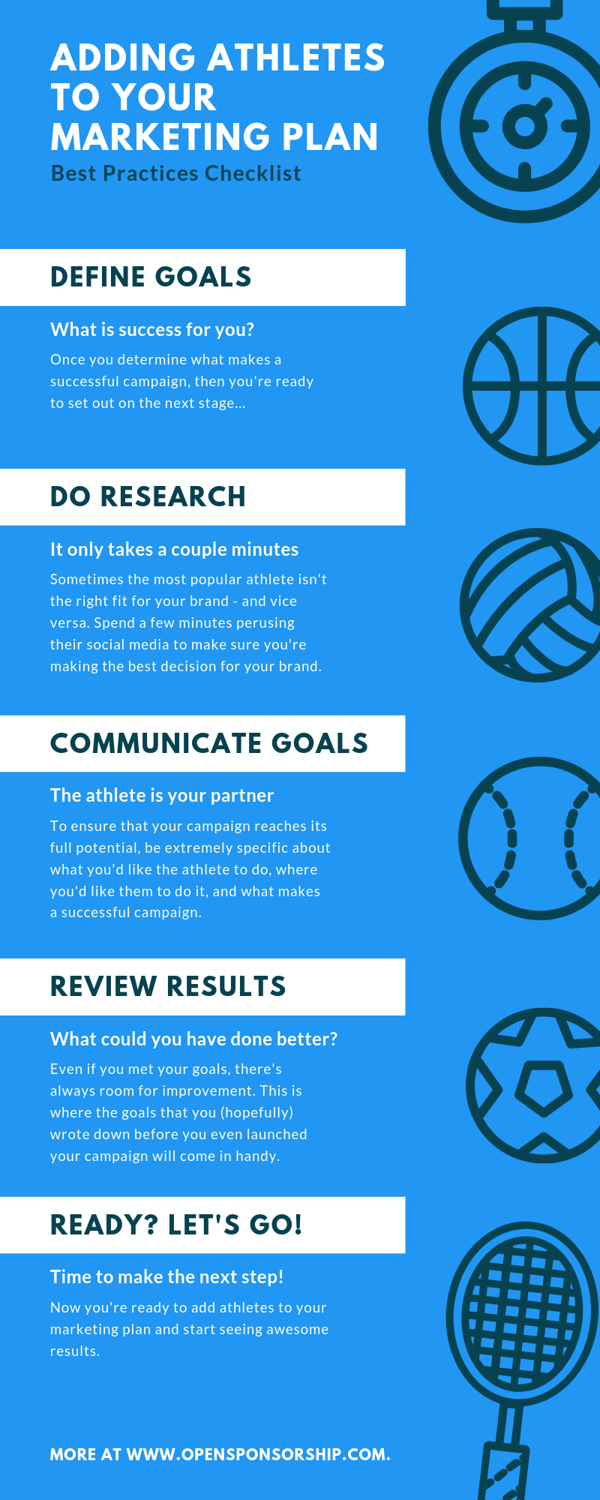Okay, it finally happened! You've just signed up for OpenSponsorship.
Now what?
Adding athletes - or any influencer - to your marketing plan is an exciting step forward, but it comes with some questions. We're here to answer them. We've taken a look at all of our clients' questions, comments, and advice ... and put them here to share the wealth. Read on to see our guide to best practices when it comes to adding sponsorships to your marketing plan.
Step 1: Define Your Goals
Are you looking to sign on an athlete to increase sales or to increase awareness? How will you measure if that's happening successfully?
Once you make those determinations, jot down a formal summary of your goals. Take them to your team or manager to ensure you're all on the same page about what success is. Setting goals is essential before starting a campaign. It provides a written record of what you did, what you wanted to happen, and, after the campaign, what actually happened. This makes it so much easier to adjust strategies and give it another go if need be!
Step 2: Do Your Research
What's right for someone else may not be right for your brand. At OpenSponsorship, we make it easy to research athletes' social accounts, proposal acceptance rates, lifestyle associations, audience reach, and other pertinent details.
Once you've thoroughly assessed your options, make a shortlist of athletes you'd be happy to work with. Compare their profiles to the goals you set for the campaign. Are any athletes an especially good match with your goals?
For example, if a goal was to raise awareness of your product to women ages 25 - 40, an athlete with a large, engaged following in that demographic is likely to help you reach your goals.
Step 3: Clearly Communicate Your Goals
Now that you've set your goals and done your research, it's time to communicate those goals. On OpenSponsorship, the athlete that you choose is your partner. They want to help you meet your goals just as much as you do - if their campaign fulfills your goals, you're more likely to work with them again.
To ensure that your campaign reaches its full potential, be extremely specific about what you'd like the athlete to do, where you'd like them to do it, and what makes a successful campaign. Once they're on the same page as you, they can take action if the campaign isn't on track to meet its goals. Maintain an open line of communication throughout the campaign and work together to make it the best it can be!
Step 4: Review Your Results
And after reviewing those results, ask yourself: What could I have done better?
Even if you met your goals, there's always room for improvement. This is where the goals that you (hopefully) wrote down before you even launched your campaign will come in handy. Compare your results to your initial goals. If you didn't achieve your goals, it's helpful to ask these questions:
- Why didn't I reach my goals?
- Was it possible to reach my goals?
- What can I do better next time?
- Who is responsible for me not meeting my goals?
Depending on your answers, you can make a decision about whether or not to try your campaign again... With a bit of rewiring, of course!
Ready to get started?Now that you have a framework to follow, it's time to make it happen. Check out of our plans and our team will help you add athletes to your marketing campaigns asap. |


